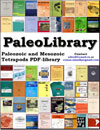
Complete Data Base of Paleozoic and Mesozoic Tetrapods.
Paleo-News and illustrations. Big electronic PDF-library.
| |
| PaleoNews |
| Classification |
| Books and Articles |
| Contact |
| Forum |
сайт о динозаврах
рейтинг сайтов
Free Counter
myspace hit counter
Guest blog: What this fossil means for Scotland |
September 15, 2016: When many people think of dinosaurs and other fossils, Scotland probably doesn’t spring to mind. The classic image of palaeontology is one of swashbuckling explorers in remote corners of the globe, deep into the desert, brushing away sand to expose ancient skeletons. But don’t be fooled by the stereotype. Dinosaurs once roamed Scotland, hundreds of millions of years ago, and they left some of their bones and footprints in one very special place – the Isle of Skye. When I moved to Scotland from the USA a few years back, I knew the Isle of Skye by reputation. I kept hearing about how beautiful it was: an otherworldly landscape of craggy peaks, windswept shores, and rolling green hills: like something out of a Tolkien book. But what I cared about most were the fossils. We now know Skye as one of the best places on the planet for preserving fossils from the middle part of the Jurassic Period, about 170 million years ago. This was a heady time in evolution. Many of the most iconic dinosaurs were just getting started: the colossal long-necked sauropods of the Brontosaurus mould, the plate-backed stegosaurs, and even the first tyrannosaurs who were then at the early stage of their evolution, and therefore no bigger than humans. The first birds were flying overhead, and primitive salamanders, lizards, and even some of our distant mammalian ancestors were scurrying underfoot. Back when this prehistoric menagerie was around, Skye was a sweltering island perched in between North America and Europe, covered in forests and crossed by rivers that emptied onto beaches rimmed by quiet lagoons. These were the perfect environments for preserving fossils. For the past four years I’ve been leading expeditions to Skye, and we’ve found some amazing things: a track site left by huge sauropods frolicking in a lagoon, the knife-like teeth of carnivorous dinosaurs, and the bones of weird dog-sized crocodiles. But what Norrie Gillies found 50 years ago, when walking on the beach near the Storr Lochs power station, is even more exciting. He saw a brown lump sticking out of the tan-coloured rocks. It was about the size and shape of an ashtray, sitting on its side. In front of it was another, and another, and another, all lined up like a row of coins. It dawned on Norrie: these were not rocks. They were fossil vertebrae - backbones. Norrie had found the skeleton of an ichthyosaur—one of the fierce reptiles that patrolled the water while dinosaurs thundered across the land. Ichthyosaurs were strange creatures, like something out of a fantasy novel. They were reptiles, close cousins of the dinosaurs. But they didn’t look like any of the reptiles around today. They looked more like dolphins. They had long, pointy heads with hundreds of cone-shaped teeth, which they used to devour fish and squid. Their arms and legs were turned into flippers and they had a fin on their back— perfect for propelling their bodies through the water at breakneck speed. The Storr Lochs Monster was three or four meters long, the size of a small boat. Ichthyosaurs are no longer with us. They went extinct a little while before the dinosaurs did, and were eventually replaced by the dolphins and sharks that we know today. We know essentially nothing about how ichthyosaurs evolved during the middle part of the Jurassic. The Storr Lochs monster is one of our only clues from anywhere in the world. And it’s a beautiful fossil too: a set of chocolate brown bones that fit together like a puzzle. That’s why I believe it could well take its place as one of the ‘Crown Jewels’ of Scottish fossils. 50 years after Norrie’s discovery the fossil is ready to be studied by our team from the University of Edinburgh and National Museums Scotland and then go on display. It’s our privilege to unveil this special fossil that reveals so much about the deep, primeval history of Scotland. http://sse.com/newsandviews/allarticles/2016/09/guest-blog-what-this-fossil-means-for-scotland/
|
